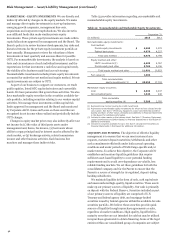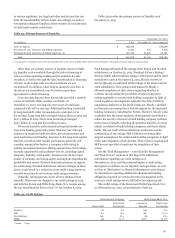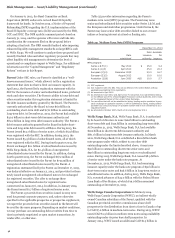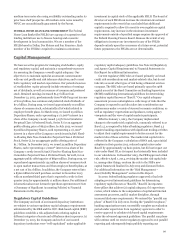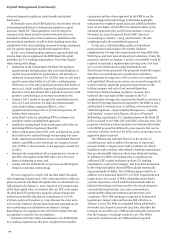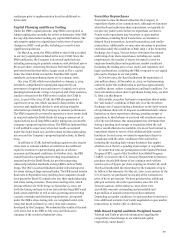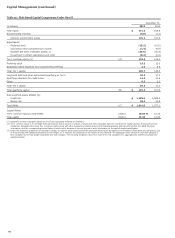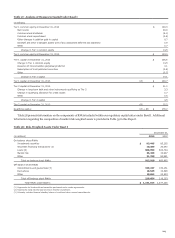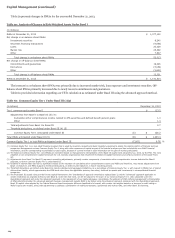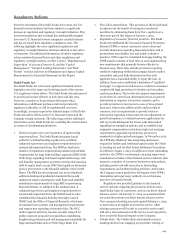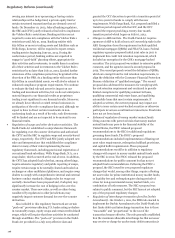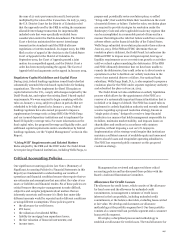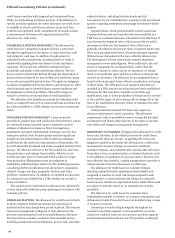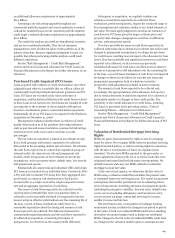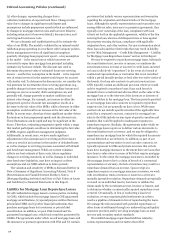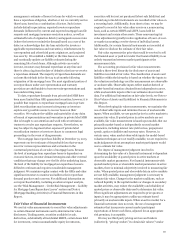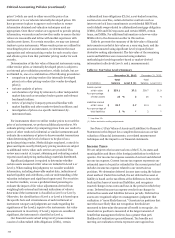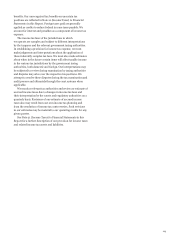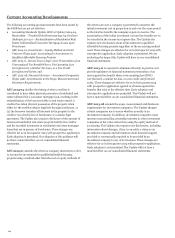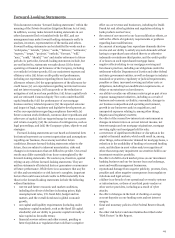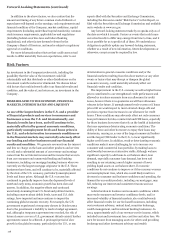Wells Fargo 2013 Annual Report Download - page 108
Download and view the complete annual report
Please find page 108 of the 2013 Wells Fargo annual report below. You can navigate through the pages in the report by either clicking on the pages listed below, or by using the keyword search tool below to find specific information within the annual report.Regulatory Reform (continued)
owning any interest in or sponsoring or having certain
relationships with a hedge fund, a private equity fund or
certain structured transactions that are deemed covered
funds. On December 10, 2013, federal banking regulators,
the SEC and CFTC jointly released a final rule to implement
the Volcker Rule’s restrictions. Banking entities are not
required to come into compliance with the Volcker Rule’s
restrictions until July 21, 2015. Banking entities with
$50 billion or more in trading assets and liabilities such as
Wells Fargo, however, will be required to report certain
trading metrics beginning June 30, 2014. During the
conformance period, banking entities are expected to
engage in “good-faith” planning efforts, appropriate for
their activities and investments, to enable them to conform
all of their activities and investments to the Volcker Rule’s
restrictions by no later than July 21, 2015. Limited further
extensions of the compliance period may be granted at the
discretion of the FRB. As a banking entity with more than
$50 billion in consolidated assets, we will also be subject to
enhanced compliance program requirements. We continue
to evaluate the final rule and assess its impact on our
trading and investment activities, but we do not anticipate a
material impact to our financial results as proprietary
trading is not significant to our financial results. Moreover,
we already have reduced or exited certain businesses in
anticipation of the rule’s compliance date and, although we
expect to have to divest certain investments in non-
conforming funds as a result of the rule, such divestments
will be limited and are not expected to be material to our
financial results.
Regulation of swaps and other derivatives activities. The
Dodd-Frank Act established a comprehensive framework
for regulating over-the-counter derivatives and authorized
the CFTC and the SEC to regulate swaps and security-based
swaps, respectively. The CFTC and SEC jointly adopted new
rules and interpretations that established the compliance
dates for many of their rules implementing the new
regulatory framework, including provisional registration of
our national bank subsidiary, Wells Fargo Bank, N.A., as a
swap dealer, which occurred at the end of 2012. In addition,
the CFTC has adopted final rules that, among other things,
require extensive regulatory and public reporting of swaps,
require certain swaps to be centrally cleared and traded on
exchanges or other multilateral platforms, and require swap
dealers to comply with comprehensive internal and external
business conduct standards. Margin rules for swaps not
centrally cleared have been proposed and, if adopted, may
significantly increase the cost of hedging in the over-the-
counter market. These new rules, as well as others being
considered by regulators in other jurisdictions, may
negatively impact customer demand for over-the-counter
derivatives.
Also included in this regulatory framework are certain
“push-out” provisions affecting U.S. banks acting as dealers
in commodity swaps, equity swaps and certain credit default
swaps, which will require that these activities be conducted
through an affiliate. The “push-out” provision in the Dodd-
Frank Act provided for a July 2013 effective date and
granted the OCC discretion to provide a transition period of
up to two years for banks to comply with the new
requirements. Wells Fargo Bank, N.A. prepared and filed a
transition period request with the OCC, and the OCC
granted the request providing a twenty-four month
transition period which began on July 16, 2013.
Changes to ABS markets. The Dodd-Frank Act requires
sponsors of ABS to hold at least a 5% ownership stake in the
ABS. Exemptions from the requirement include qualified
residential mortgages (QRMs) and FHA/VA loans. Federal
regulatory agencies proposed initial joint rules in 2011 to
implement this credit risk retention requirement, which
included an exemption for the GSE’s mortgage-backed
securities. The 2011 proposal was subject to extensive public
comment, and the agencies issued a second proposal in
2013. The second proposal revised the definition of QRMs,
which are exempt from the risk retention requirements, to
align the definition with the Consumer Financial Protection
Bureau’s definition of “qualified mortgage.” The second
proposal also addressed the measures for complying with
the risk retention requirement and continued to provide
limited exemptions for qualifying commercial loans,
qualifying commercial real estate loans, and qualifying
automobile loans that meet certain requirements. If
adopted as written, the current proposal may impact our
ability to issue certain asset-backed securities or otherwise
participate in various securitization transactions. Final rules
have not yet been issued.
Enhanced regulation of money market mutual funds.
Citing concerns with perceived risks that money market
mutual funds may pose to the financial stability of the
United States, the FSOC released proposed
recommendations to the SEC for additional regulations
governing these funds. The FSOC’s proposed
recommendations included implementation of floating net
asset value requirements, redemption holdback provisions,
and capital buffer requirements. These proposed
recommendations would be in addition to regulatory
changes with respect to money market mutual funds made
by the SEC in 2010. The FSOC released the proposed
recommendations for public comment but has not yet
adopted final recommendations. Following the FSOC’s
proposal, the SEC issued its own proposed regulatory
changes that would, among other things, require a floating
net asset value for prime institutional money market funds,
or liquidity fees and redemption gates during periods of
stress for non-governmental money market funds, or a
combination of both measures. The SEC’s proposal was
subject to public comment, but the SEC has not yet adopted
any of the proposed regulatory changes.
Regulation of interchange transaction fees (the Durbin
Amendment). On October 1, 2011, the FRB rule enacted to
implement the Durbin Amendment to the Dodd-Frank Act
that limits debit card interchange transaction fees to those
“reasonable” and “proportional” to the cost of the
transaction became effective. The rule generally established
that the maximum allowable interchange fee that an issuer
may receive or charge for an electronic debit transaction is
x
x
x
x
106


